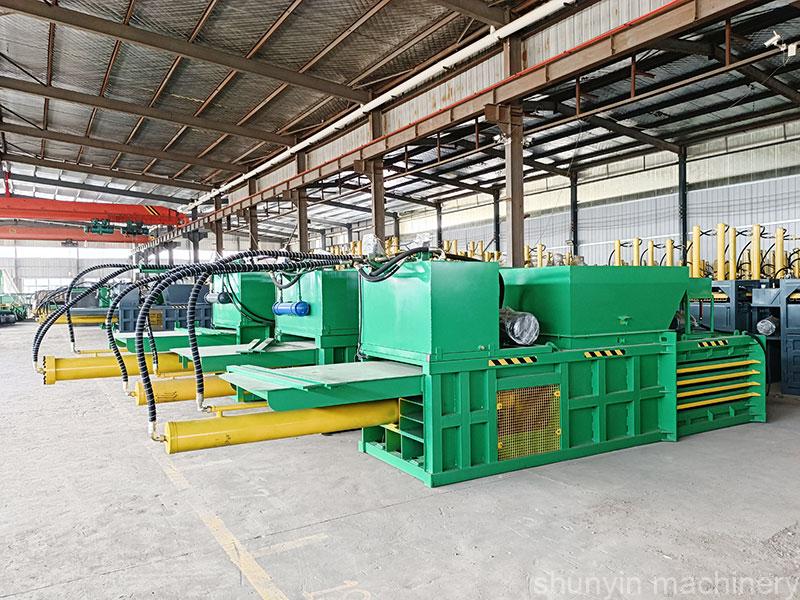Horizontal baling machines are designed to compact waste materials into uniform bales, helping businesses save valuable storage space and reduce operational costs. Let’s explore how these machines contribute to space and cost savings.
Horizontal baling machines save space and costs by:
- Space Efficiency: Compress waste into compact bales, reducing storage space.
- Lower Transportation Costs: Bales are easier to stack and transport, reducing fuel costs.
- Reduced Disposal Fees: Less frequent waste removal due to compacted waste.
- Higher Recycling Revenue1: Bales are easier to sell for higher prices at recycling centers.
- Improved Efficiency: Automated baling reduces labor and increases productivity.
- Energy Savings: Energy-efficient designs reduce electricity costs.

Horizontal baling machines play a crucial role in waste management by making waste more manageable and less space-consuming. They reduce the volume of materials, helping businesses optimize storage space and streamline the recycling process. Let’s explore how they contribute to space and cost savings.
What is the purpose of a baling machine?
Baling machines help businesses manage waste efficiently by reducing its volume, improving recycling processes, and saving on storage and transportation costs.
The primary purpose of a baling machine is to compress waste materials such as cardboard, paper, plastics, and textiles into compact, easy-to-handle bales. By reducing the volume of waste, balers help businesses save storage space, reduce labor costs, and make recycling more efficient. These compact bales are easier to transport and store, ensuring that the materials are processed and recycled effectively.

Key Functions of a Baling Machine
- Compression: Reduces the waste volume by compacting materials into bales.
- Binding: Secures the bales to keep the materials intact.
- Ejection: Releases the completed bales for transport or storage.
Table: Functions of a Baling Machine
| Function | Description |
|---|---|
| Compression | Reduces the volume of waste by compacting it into bales |
| Binding | Secures the bales to ensure the materials stay intact |
| Ejection | Releases the completed bales for handling or transport |
What is the difference between a vertical and horizontal baler?
Horizontal balers are more efficient for high-volume operations due to their higher capacity, continuous operation, and automated features. They are ideal for large businesses or recycling centers that need to process large amounts of waste quickly.
Vertical and horizontal balers differ in design, capacity, and operation. Vertical balers are compact and typically require manual loading of materials. They are ideal for small-scale operations with lower volumes of waste. Horizontal balers, on the other hand, are designed for continuous operation and can handle larger volumes of materials. They offer automatic material feeding, which improves efficiency, and are generally more suitable for high-capacity, large-scale waste management.

Horizontal vs. Vertical Baler: Key Differences
| Feature | Horizontal Baler | Vertical Baler |
|---|---|---|
| Operation Type | Continuous, automatic material feeding | Manual loading, batch processing |
| Ideal Use | Large-scale operations, high-volume waste | Small businesses, lower waste volumes |
| Capacity | Higher, capable of handling larger volumes | Lower, suitable for small operations |
What is baling in solid waste management?
Baling in solid waste management reduces waste volume, increases recycling efficiency, and optimizes storage, helping businesses save space and costs while contributing to sustainability.
Baling in solid waste management refers to the process of compressing waste materials into compact bales for easier handling, storage, and transportation. It is commonly used for materials such as paper, cardboard, plastics, and metals. Baling helps reduce the volume of waste, making it easier to manage and recycle. Additionally, baled waste takes up less space, which helps reduce landfill use and increases recycling rates.

Benefits of Baling in Waste Management
- Volume Reduction: Reduces the space required for storing waste materials.
- Improved Recycling: Makes it easier for recycling centers to process materials.
- Cost Savings: Reduces transportation and storage costs.
Table: Benefits of Baling in Waste Management
| Benefit | Description |
|---|---|
| Volume Reduction | Reduces the space needed to store waste materials |
| Improved Recycling | Optimizes materials for easier recycling |
| Cost Savings | Cuts down on transportation and storage costs |
What is the function of a baler in agriculture?
In agriculture, balers help optimize storage space, streamline transportation, and make handling agricultural products more efficient, just as they do in waste management.
In agriculture, balers are used to compress straw, hay, and other crop residues into compact bales for storage and transport. Agricultural balers come in various types, including round and square balers, and are essential for managing large quantities of harvested materials. Baled materials are easier to store, transport, and handle, helping farmers save space and reduce labor costs. Horizontal balers can also be customized for agricultural use, providing higher capacity and automated systems.

Functions of Agricultural Balers
- Compression: Compresses hay or straw into compact bales.
- Storage Optimization: Helps save space by creating manageable bales.
- Transport Efficiency: Bales are easier to move and store compared to loose materials.
Table: Functions of Agricultural Balers
| Function | Description |
|---|---|
| Compression | Compresses agricultural materials into compact bales |
| Storage Optimization | Helps store materials efficiently in less space |
| Transport Efficiency | Makes moving bales easier than loose materials |
Conclusion
Horizontal baling machines help businesses save space and reduce costs by compacting waste materials into uniform bales. Their efficiency and capacity make them ideal for large-scale operations, improving storage, handling, and transportation while supporting recycling efforts.
-
Discovering these factors can help you maximize profits from recycling efforts and improve your bottom line. ↩








